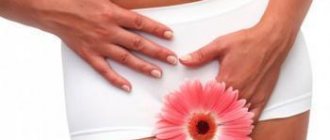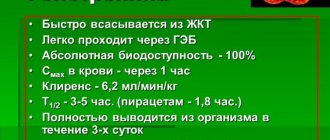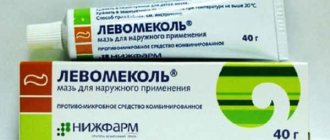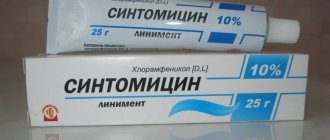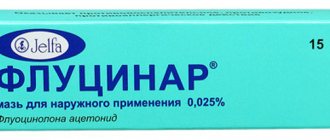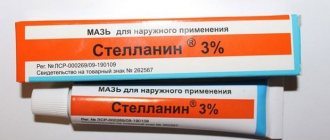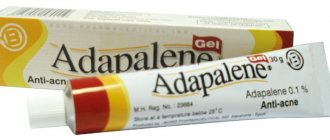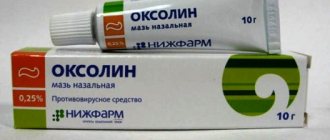Instructions for use
A special feature of using Levosin ointment is its external use. To do this, according to the attached instructions, gauze dressings should be generously saturated with this product and placed in a wound that has been previously cleaned of purulent discharge. Also, the drug can be inserted into the affected area using a catheter and a syringe, for which the drug should first be slightly warmed up for the speedy start of action of the active components (to a temperature of 34-35°C).
Gauze dressings are replaced with fresh ones several times throughout the day, which allows you to always keep the wounds clean and prevent the formation of new suppurations. The drug copes with necrotic processes at the site of the lesion, which allows you to clean the wound as much as possible before applying a fresh bandage with ointment.
During pregnancy, this drug is prescribed with caution, since the active ingredients cross the placenta and enter the fetus. Therefore, at the slightest manifestation of the irritating effect of the ointment, its use is stopped, and if a pregnant woman is allergic to any of the components, the use of Levosin is initially not allowed. . Children under 1 year of age are also limited in the use of this product.
When breastfeeding, it should be taken into account that the active ingredients penetrate into the woman’s milk and then pass into the baby’s body. Therefore, for any manifestations of malaise (allergic manifestations, irritation and rashes) in children of primary school age, one should switch to the use of another medicine with similar characteristics.
Children under 1 year of age are also limited in the use of this product. When breastfeeding, it should be taken into account that the active ingredients penetrate into the woman’s milk and then pass into the baby’s body. Therefore, for any manifestations of malaise (allergic manifestations, irritation and rashes) in children of primary school age, one should switch to the use of another medicine with similar characteristics.
Levosin price, where to buy
The price of Levosin ointment in aluminum tubes is approximately 85 rubles. In Ukraine, this product in a similar release form costs about 19 hryvnia. And the price of Levosin in banks is approximately 20 hryvnia.
Find the nearest pharmacies
- Online pharmacies in RussiaRussia
- Online pharmacies in UkraineUkraine
Europharm* 4% discount using promo code medside11
- Levosin ointment 40 gNizhpharm OJSC
77.7 rub.
Pharmacy Dialogue* discount 100 rub. using promo code medside (for orders over 1000 rubles)
- Levosin ointment (tube 40g)
81 rub.
Pharmacy IFC
- LevosinNizhpharm (Nizhny Novgorod), Russia
84.20 rub.
show more
Pharmacy24
- Levosin 40 g ointment AT "Nizhpharm", Nizhny Novgorod, Russian Federation
43.36 UAH.
- Levosin 40 g ointment tube PAT "Khimpharmzavod" Chervona Zirka", Kharkov, Ukraine
37.36 UAH.
PaniPharmacy
- Levosin ointment Levosin ointment 40g Russia, Nizhpharm
53.27 UAH.
- Levosin ointment Levosin ointment tube 40g Ukraine, Red Star OJSC
40.64 UAH.
Features of the drug
Due to its rich composition and the presence of several active components in the ointment, Levosin is popular and can be prescribed for many pathological conditions of the skin. And hydration activity ensures rapid transportation of components to the site of damage, determining the formation of new tissue, elimination of purulent masses and stopping necrotic processes.
Composition of Levosin
Being a drug with a pronounced anesthetic effect, Levosin reduces pain to an even greater extent, and does not have a large number of contraindications.
Its effect lasts longer than novocaine. This medicine contains the following components:
- chloramphenicol, a well-known anesthetic with a calming and disinfectant effect;
- sulfadimethoxine, which has proven itself in the fight against E. coli and diphtheria coli, anthrax, chlamydia, and toxoplasma;
- chloramphenicol, which quickly destroys staphylococci, gonorrhea pathogens, salmonella, and hemophilus influenzae;
- trimecaine, which belongs to the class of anesthetics and has a longer lasting effect compared to novocaine. Also, this substance has no side effects when used;
- methyluracil also has a mild anesthetic effect, combined with anti-inflammatory and non-allergic effects;
- polyethylene glycol, which prolongs the antibacterial and anesthetic effect of the remaining components of the drug several times.
The composition of Levosin allows us to understand the reasons for the wide spectrum of action of this product, as well as its active effect on various types of skin damage. According to reviews, Levosin copes well with, eliminates pain from wounds and injuries, eliminates old necrotic processes and stops the release of purulent masses.
Dosage forms
On sale today you can see Levosin in the form of an ointment, which has a uniform consistency, has a faint smell of medicinal herbs, and its color can vary slightly: from light yellow to beige with a slight greenish tint. The ointment is sold in white aluminum tubes, which are placed in cardboard packaging with instructions for use inside. The volume of the tube is 40 g. The ointment can also be offered in a jar made of dark glass, its volume is also 40 g.
The cost of the drug depends on the selling company, as well as the size of the trade markup in the pharmacy: Levosin should be purchased only at the pharmacy to avoid buying a counterfeit without the properties characteristic of this product. The price of the ointment can range from 85 to 92 rubles per aluminum tube. The cost of the drug in a jar is slightly higher: from 90 to 105 rubles.
Composition and release form
Release form of the drug Levosin: homogeneous ointment for external use, white with a yellowish tint, with a slight medicinal odor.
Active ingredients:
- chloramphenicol (chloramphenicol) – an antibiotic with a wide spectrum of bactericidal action;
- sulfadimethoxine is an antibiotic with a long-term bacteriostatic effect;
- methyluradil – a component that improves tissue trophism and stimulates the regeneration process;
- Trimecaine is an anesthetic substance.
Auxiliary ingredients:
- polyethylene oxide 1500;
- polyethylene oxide 400.
Package:
- aluminum tube of 40 g of ointment in a cardboard box along with instructions for use;
- glass jar of 50 or 100 g of product in a cardboard box with an annotation.
Compound
The effectiveness of the product is due to its unique composition.
Only five components of the drug make it the No. 1 remedy in the fight against purulent inflammatory processes:
- Polyethylene glycol. This substance acts as a base component. Its task is to penetrate the inner layers of the skin and bring other active components deep into the source of infection.
- Sulfadimethoxin (better known as chloramphenicol). This antibacterial agent actively destroys the causative agents of cholera, anthrax, and plague. Toxoplasma, chlamydia, E. coli and Haemophilus influenzae microorganisms also die as a result of the action of this substance.
- Chloramphenicol. This is an antibiotic of a different type. It is most active against coccal infections, spirochetes, Proteus, Klebsiella, gonorrhea and others.
- Methyluracil. This substance is responsible for the rapid regeneration of cells, relieves inflammation and promotes rapid healing of wounds.
- Trimekain. This local analgesic has a longer and stronger effect than novocaine. The non-toxicity of this substance allows the ointment to be used for long-term treatment of serious skin lesions.
The combination of these active components ensures the effectiveness of the drug.
The main active ingredients also include methyluracil - this substance helps relieve the inflammatory process and also accelerates tissue regeneration processes
In what cases is ointment used?
So what is Levosin ointment used for? Most often it is prescribed for the first stages of purulent wounds, including infected burns and ulcers that are difficult to heal.
In addition, Levosin is used for acne, ulcers and acne. Combining this ointment with other remedies will help get rid of furunculosis. It can also be used for simple wounds and bedsores.
The ointment is used for the following diseases and pathological conditions:
- burns;
- long-term non-healing wound surfaces, including purulent and necrotic ones;
- trophic ulcers;
The main indication for use of the product is the presence of a purulent-inflammatory process on the skin, provoked by the active development of pathogenic microorganisms - in infected burns, wounds
- acne, boils;
- keratinization of mucous membranes;
- cracks, wounds with hemorrhoids;
- panaritiums;
- postoperative sutures;
- bedsores.
Patients' opinions on the use of ointment
Most doctors and patients respond positively to Levosin ointment. During treatment, people note its effective properties. Liniment has a pleasant smell, does not stain things, and helps to cope with the most long-standing inflammatory and purulent processes. In addition, it quickly heals burn wounds and all necrotic processes with copious discharge of pus.
Patients note the ease of applying the medicine with gauze bandages. They are easily soaked in the ointment composition, then applied to cleansed areas of the skin.
Literally after 10 days, the patient’s health improves, purulent discharge decreases, and in some cases disappears completely. As a result, the wound is cleaned and the skin layers are regenerated.
People who have used Levosin ointment note that it is convenient to use. This is determined by suitable aluminum tubes, from which the contents are easily squeezed out and the required volume is simply calculated. The drug has low price parameters when compared with similar drugs.
Patients who used Levosin ointment in combination with other drugs did not observe any negative consequences or side effects.
The ointment composition can cure severe, purulent forms of skin diseases, hemorrhoids, and effectively remove pimples and acne.
Indications for use
Levosin ointment is used to treat exacerbations of external hemorrhoids, its complications and concomitant diseases, which include:
- inflammation and thrombosis of hemorrhoids;
- ulceration of nodes with bleeding;
- ascending proctitis (inflammation of the rectal mucosa);
- paraproctitis (inflammation of pararectal tissue);
- anal fissures.
The use of the drug is possible at any stage of development of the pathological process.
Overdose
There have been no reported cases of overdose with Levosin, so there are no official data on this issue.
However, there is evidence of an overdose of individual components included in the ointment composition. For example, it is known that an overdose of trimecaine causes vomiting, nausea, tremors and convulsions; an overdose of chloramphenicol is manifested by hypothermia, “gray syndrome” (due to the accumulation of the substance in the liver - the appearance of a gray tint to the skin), cardiovascular failure; Exceeding the permissible dosage of chloramphenicol may result in impaired hematopoietic function, etc. However, in Levosil the concentration of these components is minimal. But this does not mean that uncontrolled use of the ointment is allowed: strict adherence to the instructions will protect you from the unpleasant consequences associated with an overdose.
Possible unpleasant moments
"Levosin" ointment, the use of which allows you to quickly cope with purulent ulcers and fissures in the anal canal, has no special contraindications.
It is worth noting just a few precautions when using the medication:
- During the gestational period, the drug is prescribed with caution. There is not sufficient data on the risks to the fetus or infant.
- When using the ointment, an allergic rash in the form of urticaria may appear. Itching may occur. In case of individual intolerance to the components of the drug or increased side effects, treatment should be discontinued.
- The medicine should not be used by children of preschool age.
- When using Levosin, you should limit the use of oral and injectable drugs that contain chloramphenicol or sulfadimethoxine. Their use must be agreed with your doctor.
- Levosin is popular among teenagers as a means of combating acne. However, it should be understood that uncontrolled use of a drug containing antibiotic components leads to a decrease in immunity. Bacteria that cause purulent effects, on the contrary, develop resistance to the action of the active components.
Levosin ointment, reviews of which indicate its unique ability to cope with purulent-necrotic ulcerations, should not be used without prior consultation with a doctor. The use of any antibiotic drugs should be as prescribed by a doctor.
When using Levosin ointment, an allergic response from tissues may occur, which is manifested by the formation of a rash, itching and burning sensation
If the drug is used for a long time (more than one month), the condition of the peripheral blood should be monitored and tested.
Instructions for use of ointment
Antiseptic Levosin for acne is used externally. It is used to treat inflamed red areas of the skin twice a day after washing. The duration of treatment, according to reviews, is 2-3 days. Insect bites are smeared with the drug several times a day, within a day the inflammation goes away, and in three days the skin heals completely.
Levosin is used in gynecology to treat poorly healing sutures after childbirth. They are treated several times a day, the duration of treatment is 3-4 days or until the purulent contents are eliminated. For sinusitis, soak cotton swabs in heated ointment and insert them into the nostrils for half an hour. The procedure is repeated twice a day for a course of 10 days.
To treat wounds, sterile gauze pads are generously soaked with the product, applied over the affected area, or loosely filled into a deep wound. Dressings are carried out daily, the edges are first cleaned of pus, the wound is washed with hydrogen peroxide or a solution of Chlorhexidine.
It is allowed to inject the product into a narrow deep wound using a catheter or a disposable syringe. When applying, avoid contact of Levosin ointment with mucous membranes.
Before using the product, you should consult a doctor - he will determine the sensitivity of the microflora that caused the disease and take into account the individual characteristics of the patient.
Use during pregnancy and lactation
It is not advisable to use the product during pregnancy and breastfeeding, because there is no data on its safety and effectiveness during these periods. If the doctor determines that the benefit to the mother will be greater than the risk to the child or fetus, Levosin will be used as directed.
Side effects of the ointment
The use of the drug is not associated with the risk of any specific side effects. At the same time, prolonged and frequent use of Levosin can provoke the appearance of an allergic reaction on the skin in the form of a rash. Treatment in this case should be stopped.
Drug overdose
Ignoring the dosage regimen specified in the instructions entails the inevitable manifestation of side effects of Levosin in the form of skin rashes. Countering overdose consists of symptomatic therapy and temporary withdrawal of the drug.
Drug interactions
Levosin is used with caution if treatment is also carried out with other drugs. Concomitant use of Erythromycin, Clindamycin, Lincomycin is not recommended
They weaken their effect due to the binding of chloramphenicol to blood cells. The ointment reduces the effectiveness of penicillins and cephalosporins.
Alcohol compatibility
Doctors do not recommend combining alcohol intake and Levosin therapy. This is due to a possible increase in side effects, a decrease in the effectiveness of treatment, and a negative effect of the drug on the general condition of the body.
Contraindications for Levosin ointment
With prolonged use of the ointment, it is necessary to constantly monitor the condition of the peripheral blood. Contraindications to the use of Levosin:
- pregnancy, lactation;
- childhood;
- intolerance to the components of the composition;
- porphyria;
- deficiency of the enzyme glucose-6-phosphate dehydrogenase;
- eczema;
- psoriasis;
- fungal skin infections.
Description of the drug
Levosin is an antimicrobial agent with a jelly-like consistency, transparent, and with a specific antibiotic odor. The ointment is indicated for the treatment of diseases accompanied by acute or chronic inflammation. It is often included in therapeutic regimens if the patient has suppuration in pathological foci. Active ingredients help remove necrotic tissue and cleanse wounds of pus. What else does Levosin ointment help with:
- inhibits infectious pathogens that provoke the development of inflammation;
- stimulates blood circulation in damaged skin, replenishing reserves of nutrients and biologically active substances;
- normalizes microcirculation, reducing the severity of swelling;
- eliminates pain, itching, burning and stinging.
The ointment contains both an antimicrobial and antibacterial component, so it is characterized by a wide spectrum of action. And the presence of an anesthetic in the composition helps to reduce the intensity of the pain syndrome immediately after applying Levosin.
Pharmacological group and action
The action of the ointment is based on the combination of the therapeutic properties of its main ingredients. Levosin is a representative of the clinical and pharmacological group of drugs, which combine antibiotics with sulfonamides. This drug can be classified as an antibiotic for local application. It is often included in the group of stimulators of regeneration and repair of damaged soft tissue. Levosin is registered under the international nonproprietary name: Dioxomethyltetrahydropyrimidine + Sulfadimethoxine + Trimecaine + Chloramphenicol. This is the name of all components that have a therapeutic effect:
- chloramphenicol (chloramphenicol). Shows activity against gram-negative and gram-positive bacteria. Inhibits the biosynthesis of proteins necessary for the replication of microbial RNA;
- sulfadimethoxine. Prevents the growth and active reproduction of clostridia, E. coli, streptococci, staphylococci. Competitively inhibits PABA, disrupts the synthesis of tetrahydrofolic acid, from which purines and pyrimidines are produced;
- methyluracil. Accelerates metabolism in tissues affected by inflammation, removes cellular decay products from them. Methyluracil, which is part of the drug, actively stimulates regeneration by eliminating the deficiency of nutrients.
The analgesic effect of Levosin is provided by trimecaine. This active ingredient penetrates into the deepest epidermal layers. It binds to specific receptors and disrupts depolarization processes. As a result, pain impulses are blocked and do not enter the central nervous system.
Release form and composition
The domestic manufacturer produces Levosin in the form of an ointment, packaged in 40 g in aluminum tubes. Its secondary packaging is a cardboard box with instructions for use inside. The main composition of Levosin is represented by dimethyl sulfoxide, chloramphenicol, trimecaine and methyluracil. And the drug has only one additional ingredient - propylene glycol. It promotes maximum absorption of active components into pathological lesions and their optimal distribution in tissues. Performs the following functions:
- solvent;
- stabilizer;
- conservative.
The weak antiseptic activity of propylene glycol has been proven. The shelf life of the drug is 24 months. Once the aluminum tube is opened, it is limited to 2-3 weeks. Levosin should be stored in a dark place where access to small children should be limited. The optimal temperature is 15-20°C.
Composition of the drug
Levosin is produced in aluminum tubes with a capacity of 40 g, or in dark glass jars of 50 and 100 g. The medicine is placed in a cardboard box and supplied with instructions for use.
The ointment is a yellowish or white substance of uniform consistency.
The drug contains:
- levomitin (chloramphenicol) 10 mg;
- sulfadimethaxine 40 mg;
- methyluracil 40 mg;
- trimecaine 30 mg.
Levomycetin, international trade name – chloramphenicol – is an antibiotic active against a large number of gram-positive and gram-negative bacteria. It has a bacteriostatic (deprives bacteria of the ability to reproduce) and bactericidal (completely destroys the infectious agent) effect.
Levomycetin is able to cope with pneumococci, streptococci, staphylococcus, meningococcus, and is most active against pathogens of intestinal infections, which are Escherichia coli, Proteus, and salmonella.
Sulfadimetaxine is an antibacterial drug related to sulfonamide derivatives. Effective for wound infections, pyoderma, erysipelas. Sulfanilamide and chloramphenicol are on the list of vital medications and provide a complex effect on infectious agents, ensuring a rapid cessation of inflammation.
Methyluracil promotes tissue regeneration and has anti-inflammatory and immunostimulating effects. Ensures rapid wound healing and skin restoration.
Trimecaine is a strong analgesic. It has a long-lasting effect, is characterized by low toxicity, and does not cause irritation when applied topically. Its action provides a serious analgesic effect, since the drug is much stronger than novocaine.
Thus, the drug not only effectively fights infection, but also relieves pain and promotes rapid healing of damaged areas.
The medicine has the following effects:
- Regenerating. Restores the skin, mucous membranes, and prevents premature tissue scarring. Scars very rarely appear after using it.
- Anti-inflammatory. Reduces inflammation and redness in both small and large areas of the skin, in deep wounds.
- Healing. Tightens the wound surface, creates a protective film on it.
- Decongestant. Relieves swelling and swelling, especially effective if the wound is post-operative.
- Antimicrobial. Effective against most bacteria.
- Local anesthetic. It has an analgesic effect at the site of application, which is positive in the treatment of deep skin lesions and hemorrhoids.
The drug is available in the form of an ointment on a fatty basis, which allows the active ingredients to be quickly absorbed. Contains the following components:
- “Chloramphenicol” (“Levomycetin”) – 10 mg. A broad spectrum antibacterial agent with a bacteriostatic effect. "Chloramphenicol" does not kill bacteria, but significantly disrupts the processes of their development and growth. The ointment easily penetrates tissues, transporting all active components
- "Sulfadimethoxine". The antibacterial substance is effective against most known gram-positive and gram-negative bacteria.
- "Methyluracil". A healing substance that regenerates mucous membranes and tissues.
- "Trimekain". A very powerful analgesic component. Does not cause irritation in the area of application. The action is stronger than "Lidocaine" and "Novocaine".
For one reason or another, it may be necessary to select a substitute for the prescribed drug that would have the same spectrum of beneficial effects and list of indications
Instructions for use
It is important to understand that any medication should be used only as prescribed by the attending physician. Levosin is an antimicrobial and anesthetic ointment intended for external use.
Before applying the ointment, the injury site must be cleared of necrotic tissue. Alcohol liquids, as well as antiseptics (for example, hydrogen peroxide) are suitable for this purpose. It is the daily treatment of the wound, coupled with the use of a healing ointment, that makes the process of restoring damaged tissue as fast and effective as possible.
The product must be applied to the surface of the wound, and then cover the damaged area with a sterile bandage. It is important that the ointment is applied fairly loosely to the wound. In this case, the number of applications and duration of therapy are individually determined by the attending physician. During the day, it is necessary to change the dressings to clean ones several times, this will avoid the reappearance of pus. Moreover, before each application of the ointment, the wound must be thoroughly treated with an antiseptic and cleaned of any residual product.
Quite often there is a method of applying ointment heated to body temperature to the wound area using a syringe without a needle or catheter. However, this method is more suitable for hospital conditions than for home use.
The product can be used not only externally, but also intravaginally in the treatment of gynecological problems. Most often it is prescribed for erosive formations on the cervix or vaginosis of a bacterial nature.
You should not resort to such therapy without first consulting a gynecologist and taking a smear to determine the type of pathological microflora. Treatment involves inserting tampons soaked in the composition into the vagina overnight.
To treat lesions in the anal area, it is advisable to soak sterile wipes with the product and apply them several times a day. The decongestant property of the ointment allows it to be used in complex therapy of internal hemorrhoids. As in the previous case, the product is administered internally using tampons.
with purulent manifestations using Levosin is also effective. The fact is that the product has an antimicrobial, anti-inflammatory and healing effect, which allows not only to cure existing rashes, but also prevents the appearance of new ones. After washing with a deep cleanser, Levosin is applied in a small amount to damp facial skin. After an hour, the remaining composition can be wiped off with a dry cloth.
The procedure is carried out twice a day until the rash disappears completely. In severe cases of purulent skin lesions on the face, it is advisable to apply applications with ointment, rather than just smear.
Necrotic formations as a result of trophic disorders are also treated with bandages with ointment. To do this, apply sterile bandages impregnated with the composition to the bedsores. To speed up healing and prevent further spread, the patient must also be positioned in such a way that the damaged area is not subject to further compression. Sometimes special rubber circles are used for this purpose, which allow you to keep bedsores suspended.
Furunculosis is a systemic disease, so the doctor must determine the cause of inflammation. However, the external manifestation can be removed with the help of Levosin. To do this, compresses with ointment are applied to the previously disinfected area. The bandage must be changed three to four times a day. This will not only relieve pain, but also reduce swelling and inflammation.
Features of application
Of course, before using Levosin, like any other medicine, you should consult your doctor.
The standard form of treating hemorrhoids with this medicine is as follows: apply the ointment on a napkin, apply it to the anus or the site of inflammation of the node, hemorrhoidal lump, secure with a bandage or secure with a bandage.
It is allowed to apply the ointment directly to the affected area. This procedure should be carried out twice a day for 7-10 days. Doctors do not recommend a longer course, because The product contains antibiotics.
What is the best analogue
There is no complete analogue of Levosin. This is the only drug that combines 4 ingredients. But there are other drugs with chloramphenicol, for example, Levomekol and chloramphenicol ointment. Only a doctor can tell which of them is better to use in a particular case.
Comparison with Levomekol
The most similar composition is found in a drug called Levomekol. In addition to chloramphenicol, this ointment also contains methyluracil. Its effects are the same as Levosin, with the exception of pain relief, and the spectrum of antibacterial activity does not include chlamydia.
The difference is that Levomekol can be used in children (from 3 years of age). Otherwise, the drugs have many similarities - the method of use, indications, side effects and contraindications are almost identical. The decision on whether to use Levomekol or Levosin should be based on the specific clinical situation.
In dermatology, it is difficult to do without antibacterial agents. Levosin is a combination ointment with chloramphenicol, which is actively used to treat infected wounds, burns and other diseases of microbial inflammatory origin, including acne. But specific recommendations for its use for each patient should be given by a doctor.
Levomekol and Levosin - what is the difference and what is better?
Despite the fact that these two local drugs are often called substitutes for each other, it cannot be said that they are the same thing. Thus, the antibacterial action of both compositions is based on two active components - chloramphenicol and methyluracil, but this is where the list of active ingredients of Levomekol ends. The difference is that Levosin contains two additional components that are responsible for relieving pain and accelerating tissue regeneration processes, which makes therapy more comfortable and productive for the patient. In addition, Levosin ointment is also cheaper than Levomekol, which often tempts people to purchase it, although they are equally effective in combating pathogenic flora.
Side effects and contraindications
When using Levosin ointment, an allergic response from tissues may occur, which is manifested by the formation of a rash, itching and burning. It is worth understanding that the longer and more often the product is used, the higher the risk of adverse reactions from the immune system becomes. For this reason, it is better not to start using the ointment without a doctor's prescription.
The composition is applied topically, and based on this, it has a limited list of contraindications for its use. Thus, it is necessary to refuse to apply the product if there is an individual intolerance to at least one component of the composition. You should not apply the remedy for herpes on the lips, as it has no effect on viruses and will not give any result. The manufacturer does not provide information about drug interactions, but in case of complex therapy with several drugs at once, it is better to maintain a pause between them for at least 30-60 minutes.
Instructions for use of Levosin ointment
According to the official annotation, the ointment is used topically. The composition is impregnated with sterile napkins, which are loosely placed into the wounds. If there is a deep wound pocket or cavity filled with pus and necrotic masses, it is allowed to administer an ointment heated to body temperature through a catheter, drainage tube or syringe. All manipulations are carried out until the wound is completely cleansed and the tissue heals.
Before starting the procedure, which it is advisable to entrust to a professional, the surface of the wound is cleaned of secretions and necrotic tissue, and also treated with an antiseptic, for example, three percent hydrogen peroxide.
Dressings are carried out once or several times a day, depending on the condition of the wound and the course of the pathological process. The method of administration, dosage, frequency of procedures and duration of therapy in each specific case should be determined by the treating dermatologist.
When treating minor acne (acne), the composition is applied to a previously cleaned and disinfected face with an antiseptic (for example, calendula tincture diluted in half with water or hydrogen peroxide (3%)) in a thin layer, and after some time it is washed off with water.
If there are single acne, the ointment is applied using a cotton swab, generously moistened with ointment, in a targeted manner, after which a sterile gauze pad or cotton pad is placed on top. After an hour, the drug is washed off the skin.
Instructions for use
Indications for use
Levosin is prescribed by dermatologists as an effective dermatological agent. For internal use, this ointment is used only in exceptional cases, when it is administered by catheter in a hospital setting and under the full supervision of a physician.
This medicine actively acts on bacteria and staphylococci, as well as intestinal, hemophilus influenzae, and chlamydia due to the presence of sulfadimethoxine in its composition. And with the help of trimecaine, the ointment acts as an anesthetic, and it has a much stronger effect compared to novocaine.
The ointment does not irritate the skin and completely restores damaged tissue.
Composition of the drug and its effect
Levosin is a combination drug, each component of which has its own effect.
| Substance | Action |
| Chloramphenicol | Actively affects pathogenic microorganisms that lead to the appearance of purulent contents. |
| Sulfadimethoxine | It is active against bacteria such as shigella, chlamydia, toxoplasma, and clostridia. |
| Methyluracil | Accelerates wound healing, stimulates cellular protection factors. |
| Trimecaine hydrochloride | Local anesthetic, acts stronger and longer than procaine (novocaine), low toxicity, non-irritating. |
| Water Soluble Polyethylene Glycol | Ointment base. |
Levosin is sold in tubes of 40 grams and is a white ointment with a yellowish, greenish or slightly brownish tint.
The combined composition of the ointment provides an antibacterial, anti-inflammatory and local anesthetic effect when used.
At the same time, the ointment is a mild local action product, which has its positive aspects. Due to its rich composition, Levosin acts quickly and comprehensively, but the medicine does not affect the digestive tract and other internal organs.
Another advantage is that Levosin does not have cumulative properties, i.e. the substances it contains do not accumulate in the body.
Levosin ointment was once developed as a means for treating infected wounds, especially in the first phase of the wound process. The ointment was used very successfully: in just 2-3 days it reduced swelling and cleansed the wound of purulent-necrotic contents. Later, the medicine was also used to treat burns and difficult-to-heal ulcers.
Analogues of the drug
There are many external antibacterial drugs for the treatment of purulent wounds. These are “Levomethyl”, and “Lingesin”, and “Streptonitol”, and others. But the closest in composition and scope of application is Levomekol ointment. According to reviews from doctors and patients, their effectiveness is almost the same, and the price is also similar - a package can be purchased for 70-100 rubles. The only difference is that Levosin contains a local anesthetic, so if you have a strong pain symptom, it is better to use it. But, in general, the ointment “Levosin” or “Levomekol” is often recommended.
Composition and effect of the drug
Ointment for topical application has a pronounced antibacterial effect, relieves pain, and also helps accelerate tissue regeneration processes. Antibacterial activity is due to two main components in the composition, namely:
- Chloramphenicol (better known as chloramphenicol) (10 mg per 1 gram of product) – exhibits activity against gram-positive (staphylo- and streptococci) and gram-negative microorganisms (Escherichia coli, salmonella, shigella, proteus, hemophilus influenzae, neisseria, etc.);
- sulfadimethoxine (40 mg per 1 gram of ointment) – active against cocci, shigella, intestinal, plague and hemophilus influenzae, clostridium, zlamydia and toxoplasma.
The main active ingredients also include methyluracil - this substance helps relieve the inflammatory process and also accelerates tissue regeneration processes. Trimecaine in the composition is an anesthetic component that has a strong and long-lasting effect, but does not irritate the tissue.
Auxiliary components are substances such as macrogol 150 and 400 - they allow you to create the necessary texture and provide the desired concentration of active ingredients. The drug is available in two packaging options - in jars and tubes of 40, 50 and 100 grams.
How to use the cream
Levosin cream is a combined drug with broad antimicrobial, necrolytic, anti-inflammatory, analgesic effects. Actively fights gram-positive and gram-negative microorganisms.
The cream has a water-soluble base of white-yellow color, which significantly increases the antibacterial effect. Levosin is applied to the surface of the skin using point movements or using a gauze bandage. Its properties affect tissue connections without damaging biological membranes.
The cream, like the ointment, relieves:
- swelling;
- purulent inflammatory processes;
- actively used in the treatment of pimples, boils and acne;
- the cream is used for burns of the skin;
- treats difficult-to-heal ulcers.
The drug does not have negative consequences or complications. It is not advisable to apply the cream in combination with medications that inhibit blood flow.
The cream composition has a shelf life of two years; under no circumstances should it be used after the expiration date. Levosin cream is sold in every pharmacy in aluminum tubes of forty grams, without a prescription.
Almost every person who goes to a pharmacy to buy medicine hears a frequently asked question from the pharmacist: “Should I give you a cream or ointment?” It is often difficult to answer the question posed; not every person is aware of how they differ.
Levosin cream, like ointment, is used externally. The composition of both drugs is equipped with the same healing elements, the only difference is in the base. Let's take a closer look:
Levosin ointment is predominantly oily, with minimal or no water content. The ointment base includes: fat, petroleum jelly or lanolin.
The effectiveness of the drug lies in the creation of a certain membrane on the skin, which protects the skin from external damage and penetrates deep into the tissues. This allows you to improve blood flow in the body, relieve pain from wounds and promote rapid healing.
Levosin cream is similar in appearance to an emulsion. It is not greasy, the lighter one does not stick out as a film on the skin.
The drug acts on the surface cells of the skin. It does not have the ability to penetrate deep into the body or into the bloodstream, for this reason the healing properties of the cream are usually called local or local.
The cream product contains a large amount of distilled liquid. Therefore, the drug actively moisturizes and cools the skin layers. The disadvantages of Levosin cream include the possibility of it appearing in the form of stains on clothes.
The result is this: the cream has a therapeutic effect on the surface layers of the skin, and the ointment penetrates deep into the tissue joints. The cream is more effective for burns and rashes, the ointment for hemorrhoids, boils and relieving pain symptoms.
Instructions for use Levosin ointment 5 (100%) 5 votes
This will help:
Instructions for use of Levosin ointment
The instructions clearly indicate that the product is used exclusively for external use. Thus, the use of ointment involves applying it to a clean gauze bandage, and only after that covering the affected area of tissue with the created overlay - this allows for loose distribution of the drug and minimizes mechanical impact. Such manipulations are performed daily; the bandage must be changed, applying a new portion of ointment every day (the doctor may prescribe a more frequent change - twice a day).
The daily dosage for adult patients should not exceed 3 grams of chloramphenicol. The course of therapy is determined individually depending on the condition of the tissues and the characteristics of the situation - it is recommended to repeat the procedure until the skin lesion is completely cleansed of dead tissue and pus. Usually, after 1-2 days, swelling and severe inflammation disappear, and within 3-4 days, improvements in the course of purulent processes are noticeable.
Another way to use the product is to inject it into the purulent cavity through a catheter using a syringe. In this case, it is necessary to preheat the composition to the patient’s body temperature. When using the drug in gynecology for purulent-inflammatory processes, a tampon soaked in the product is inserted into the vagina, which is changed several times a day.
Levosin ointment: what is it used for?
Content
Levosin was developed in the 1970s, and we owe this to the Kharkov Pharmaceutical Institute, where scientists worked on creating ointments for infected wounds. For quite a long time, Kharkov residents were unable to obtain approval for mass production of the ointment, since higher ranks did not want to see obvious evidence of its effectiveness. However, there were rumors about a miracle remedy, and very authoritative people tried it on themselves. Clinical trials of the ointment were carried out among military surgeons, and they noted the beneficial properties of Levosin in extreme conditions with extensive damage to the population - the ointment prevented the spread of the purulent-inflammatory process, “preserving” the wound for up to 48 hours. This made it possible to delay surgical intervention, which was later successfully used by surgeons in Afghanistan and during the earthquake in Armenia.
Today, Levosin alone is sold monthly in quantities exceeding 500,000 packages. The ointment is prescribed as an anti-inflammatory agent, and its effectiveness against microbes (staphylococci, Pseudomonas aeruginosa and Escherichia coli) has also been proven. Penetrating into tissues without damaging biological membranes, Levosin stimulates their regeneration. Moreover, in the presence of pus and necrotic masses, the antimicrobial effect of the ointment remains.
Composition of the drug
Levosin contains:
- trimecaine, which has an anesthetic effect;
- chloramphenicol – a broad-spectrum antibiotic;
- methyluracil – a substance that improves tissue trophism and accelerates regenerative processes;
- sulfadimethoxine – antimicrobial agent;
- chloramphenicol – antibiotic;
- water-soluble polyethylene glycol – ointment base.
The uniqueness of the combined composition of Levosin is the absence of auxiliary components, and all components of the ointment are equally active in forming a pronounced therapeutic effect.


